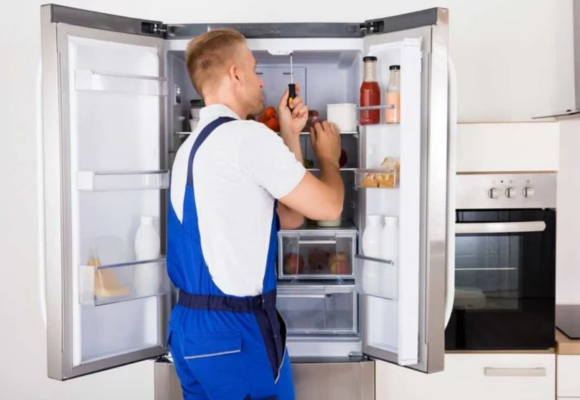Picture this: you’re prepping for a big backyard BBQ, your freezer is loaded with all the essentials, but in the hustle of getting everything ready, you accidentally leave the freezer door slightly ajar. This small slip-up, a freezer door left open just a crack, can lead to a big BBQ bummer. In this article, we’re going to chew over what happens when your cold storage isn’t as cold as it should be. We’ll talk about how this tiny gap can impact everything from your prized brisket to those frozen popsicles, not to mention cranking up your energy bill. Don’t fret though, we’ve got your back with some handy tips on how to fix the situation before it puts a damper on your grill party and ways to prevent it from happening when you’re in the middle of BBQ hustle.
What to Do if Your Freezer is Left Open Overnight
Discovering your freezer door slightly ajar can certainly be a moment of concern, but fear not! There’s a straightforward way to manage this situation. First, assess the extent of the thawing. If the freezer temperature is still relatively cold, and the food has ice crystals or is as cold as if in a refrigerator, it’s generally safe to refreeze. The key here is the ice crystals – their presence indicates the food hasn’t completely thawed.
However, take a moment to inspect each item. If you find meat, poultry, or fish that has completely thawed and has been warmer than 40°F for over two hours, it’s safer to discard them to avoid any risk of foodborne illness. For other items like frozen vegetables or bread, if they’re thawed but cold, they can be safely refrozen. The texture might change, but they will still be safe to eat.
In this situation, it’s crucial to adjust the temperature setting of your freezer to its coldest and allow it a few hours to stabilize. Once the temperature is back to normal, you can rearrange your items, ensuring they’re properly stored for optimal freezing.

- Assess the Situation: Check the freezer’s internal temperature. If it’s above 40°F, it’s crucial to act quickly.
- Check Your Food: Inspect each item. If anything has completely thawed, especially meat or fish, assess its safety.
- Salvage What You Can: Items still containing ice crystals or feel refrigerator-cold can be refrozen, but their quality may be affected.
- Dispose of Unsafe Food: If in doubt, it’s better to be safe than sorry. Dispose of any items you’re unsure about.
- Clean and Reset: Once you’ve sorted the food, clean the freezer to prevent any cross-contamination. Reset the temperature and ensure the door is securely closed.
- Monitor the Freezer: Keep an eye on the freezer for the next few days to ensure it’s functioning correctly.
By following these steps, you can minimize food waste and ensure your food safety.
The Freezer Was Left Open, Now What?
If you find your freezer door was left open, the immediate step is to close it and check the temperature. The internal temperature plays a pivotal role in determining the safety of your food. Most freezers are set at 0°F, the ideal temperature for preserving food. If the temperature has risen but is still below 40°F, the risk is minimal, and your food is mostly safe.
Here’s what you can do next:
- Check for Thawing: Go through each item. If anything has thawed completely but is still cold, cook it as soon as possible if it’s raw. Cooked food that has thawed can be eaten or refrozen if it’s still cold.
- Reorganize: After ensuring all items are safe, reorganize your freezer. Make sure there’s enough air circulation around items, as this helps maintain a consistent temperature throughout.
- Monitor Temperature: For the next few hours, keep an eye on the freezer’s temperature. It should return to its usual setting relatively quickly.
- Preventive Measures: Consider this a learning opportunity. Maybe it’s time to invest in a freezer alarm or a latch to prevent future incidents.
Why Can’t We Refreeze Thawed Food?
There’s a common misconception that refreezing thawed food is a complete no-go. However, the truth is more nuanced. The main concern with refreezing thawed food, particularly meat, poultry, and fish, is the risk of bacterial growth. Bacteria thrive at temperatures between 40°F and 140°F, known as the ‘danger zone’. When food is thawed, especially in this temperature range, bacteria can multiply rapidly.

However, if the food has been thawed in a refrigerator and is still below 40°F, it’s generally safe to refreeze. The quality of the food may diminish due to moisture loss during thawing, but it’s safe from a health perspective. This applies to many foods, including bread, fruits, and vegetables.
In the end, it’s a matter of safety and quality. While refreezing thawed food is not ideal, it’s not always a strict no. It’s about understanding the conditions under which the food was thawed and making an informed decision.
Refreezing thawed food is often discouraged due to safety and quality reasons:
- Bacterial Growth: When food is thawed, bacteria that were present before freezing can start to multiply. Refreezing doesn’t destroy these bacteria; it simply puts them into a dormant state. When thawed again, bacteria can multiply to dangerous levels.
- Texture and Flavor Loss: Freezing, thawing, and refreezing can significantly alter the texture and flavor of food. Water molecules expand when frozen, damaging the cell structure of food. This process, repeated, can lead to mushy and unappetizing results.
- Nutrient Degradation: Each freeze-thaw cycle can result in nutrient loss. Vitamins and minerals can be degraded or leached out, reducing the nutritional value of the food.
- Safety Guidelines: Food safety authorities recommend against refreezing thawed food due to the increased risk of foodborne illnesses.
While some foods may be safe to refreeze under certain conditions, it’s important to prioritize safety and quality to ensure the best dining experience and health standards.
The Unseen Opportunity of a Slightly Ajar Freezer Door
A Warm Welcome to Cool Discoveries
Picture this: a bright, sunny day, perfect for a barbecue with friends and family. In the midst of all the fun, you notice your freezer door isn’t fully closed. It’s a common mishap, one that could happen to anyone. Instead of worry, let’s explore this as an opportunity to learn and grow.
Understanding Your Freezer’s Hidden Strengths
First, it’s essential to appreciate the resilience of modern freezers. They’re designed to withstand various conditions while keeping your food safe and fresh. A slightly open door is a chance to see this marvel of technology in action, maintaining cool temperatures even when faced with a challenge.
The Silver Lining: Inventory Time!
An open freezer door is the perfect excuse for a little inventory. Think of it as a treasure hunt - who knows what delightful treats you might rediscover? That long-forgotten ice cream or those berries for a spontaneous smoothie? It’s like finding hidden gems in your very own kitchen.
Energy Efficiency Awareness
This unexpected event can also heighten your awareness of energy efficiency. It’s a nudge to be more mindful of how we use our appliances, leading to more sustainable habits. This awareness can ripple out to other areas of your life, fostering a more eco-friendly lifestyle.
Strengthening Family Bonds Through Problem-Solving
Here’s where the barbecue spirit shines through. Turning a problem into a family activity can strengthen bonds. Gather your loved ones, assign roles, and work together to restore order. It’s teamwork at its finest, reminiscent of teaming up to grill the perfect steak.
Learning and Growth: A Step Towards Appliance Mastery
Every challenge is a learning opportunity. Dealing with an open freezer door teaches you about proper maintenance and care for your appliances. It’s a step towards becoming a household appliance guru, always ready to handle whatever comes your way.
The Joy of a Fresh Start
Once everything is back in place, you get to experience the joy of a fresh start. A reorganized, efficiently packed freezer is not just aesthetically pleasing; it’s a symbol of your ability to handle life’s small curveballs with grace and positivity.
Safety First: Keeping Food Fresh and Safe
While we focus on the bright side, safety is paramount. This incident is a gentle reminder to check the safety of your food. It’s an important lesson in food safety, ensuring that you and your loved ones always enjoy meals that are not just delicious, but also safe.
Embracing the Unexpected with a Smile
Life is full of unexpected moments, just like a surprise guest at a barbecue. Embracing these moments with a positive attitude can transform them into memorable experiences. A freezer door left ajar is no different. It’s a chance to smile, adapt, and grow.
Conclusion: Celebrating the Small Things
In conclusion, a freezer door left open a crack isn’t just a minor household mishap. It’s a reminder of the resilience of our appliances, an opportunity for family bonding, a lesson in energy efficiency, and a prompt to embrace life’s little surprises with a positive attitude. So, the next time this happens, remember the warmth of a barbecue gathering – adapt, smile, and make the most of the moment.

